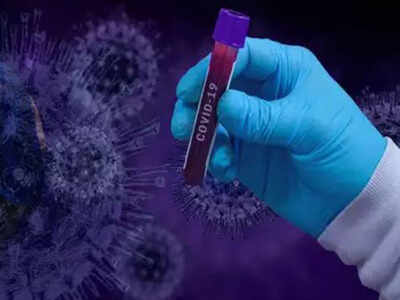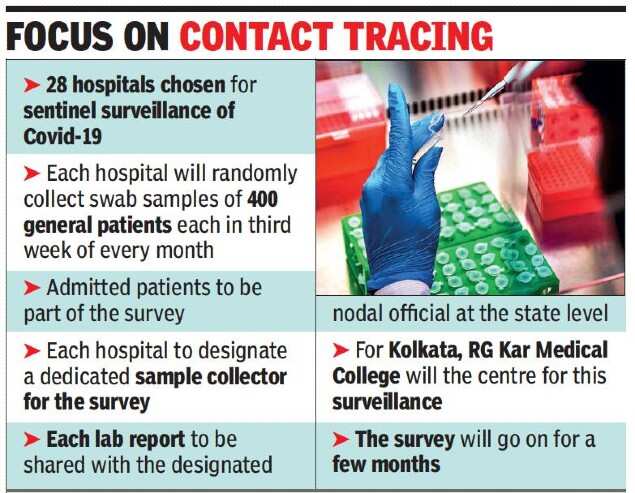Top Searches
- News
- City News
- kolkata News
- West Bengal: Sentinel survey to fight Covid surge
West Bengal: Sentinel survey to fight Covid surge

Picture used for representational purpose only
KOLKATA: Fresh Covid-19 cases in Bengal have now trickled down to three-digit figure for 10 straight days. But the state government is keeping its ante up on the virus. The health department has launched sentinel surveillance to assess the Covid situation with the aim to zero down on the geographic spread of the virus, its intensity of transmission and severity of trends.
For this purpose, 28 government hospitals have been chosen. A hospital will collect 400 samples each in the third week of a month from general patients apart from the ones coming with Covid symptoms and get these samples tested for Covid-19. In case a patient tests positive, there will be contract-tracing and identification of the locality to see if more asymptomatically infected patients are in that locality.

“Currently, Covid is not that visible due to the decline in number. Random testing will give an assessment on what is going on actually. When Covid surge slows down, you might find one out of 100 testing positive against say 20 positives when the surge was up. The continuous sentinel surveillance will give you an indicator if the number is going up from one in 100. Even if the number of rising slowly, we can get a sense that the outbreak is picking up,” said IPGMER hepatology head Abhijit Chowdhury, a member state’s expert committee for countering the possible third wave.
“This kind of epidemiological survey will be helpful in combat policy where an effort can be put to douse the flame before the fire gets too ferocious,” Chowdhury added.
Four hundred samples from each of these 28 hospitals will be collected starting the third week of July and will be tested in attached labs. The cycle will go on every month. People who come for Covid-19 test are generally those with either symptoms or has had a close contact with a positive patient. But for this surveillance, samples will be collected only from patients who come for treatment of other ailment.
“This will help trace the hidden/missing cases as many patients remain asymptomatic. Contract-tracing can further help identify particular zones to see if there are other asymptomatic patients in that zone. In such a case, containment and other preventive measures can go a long way on the face of the third wave,” said public health specialist Anirban Dalui, who is attached with Swsathya Bhawan.
Senior physician Sukumar Mukherjee said that testing asymptomatic patients can give a more comprehensive clue on the actual burden of the infection. “Picking out such cases through the surveillance would be an effective way of containment while raising the much needed number of tests,” said Mukherjee, a member of Bengal’s Global Advisory Board on Covid-19.
For this purpose, 28 government hospitals have been chosen. A hospital will collect 400 samples each in the third week of a month from general patients apart from the ones coming with Covid symptoms and get these samples tested for Covid-19. In case a patient tests positive, there will be contract-tracing and identification of the locality to see if more asymptomatically infected patients are in that locality.

“Currently, Covid is not that visible due to the decline in number. Random testing will give an assessment on what is going on actually. When Covid surge slows down, you might find one out of 100 testing positive against say 20 positives when the surge was up. The continuous sentinel surveillance will give you an indicator if the number is going up from one in 100. Even if the number of rising slowly, we can get a sense that the outbreak is picking up,” said IPGMER hepatology head Abhijit Chowdhury, a member state’s expert committee for countering the possible third wave.
“This kind of epidemiological survey will be helpful in combat policy where an effort can be put to douse the flame before the fire gets too ferocious,” Chowdhury added.
Four hundred samples from each of these 28 hospitals will be collected starting the third week of July and will be tested in attached labs. The cycle will go on every month. People who come for Covid-19 test are generally those with either symptoms or has had a close contact with a positive patient. But for this surveillance, samples will be collected only from patients who come for treatment of other ailment.
“This will help trace the hidden/missing cases as many patients remain asymptomatic. Contract-tracing can further help identify particular zones to see if there are other asymptomatic patients in that zone. In such a case, containment and other preventive measures can go a long way on the face of the third wave,” said public health specialist Anirban Dalui, who is attached with Swsathya Bhawan.
Senior physician Sukumar Mukherjee said that testing asymptomatic patients can give a more comprehensive clue on the actual burden of the infection. “Picking out such cases through the surveillance would be an effective way of containment while raising the much needed number of tests,” said Mukherjee, a member of Bengal’s Global Advisory Board on Covid-19.
FacebookTwitterLinkedinEMail
Start a Conversation
end of article
